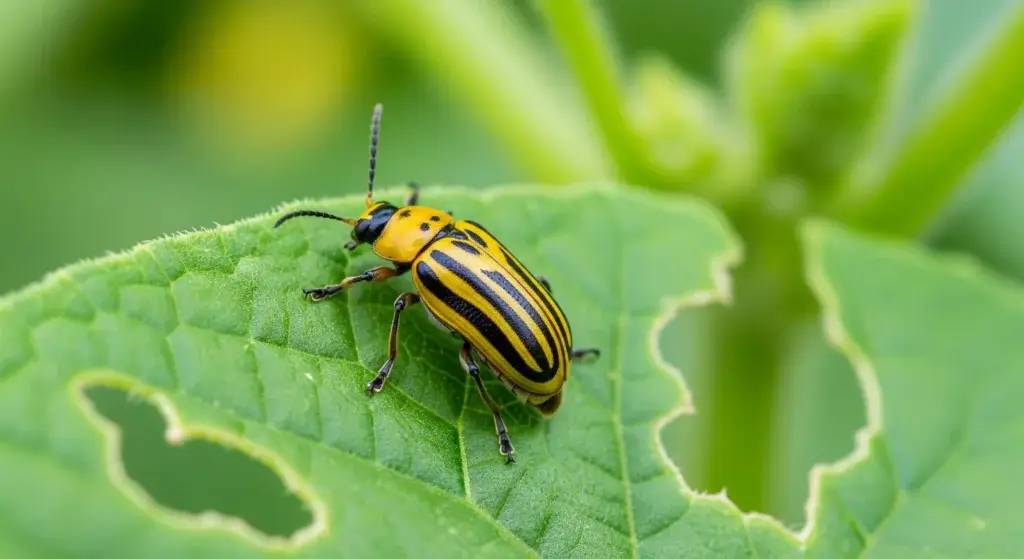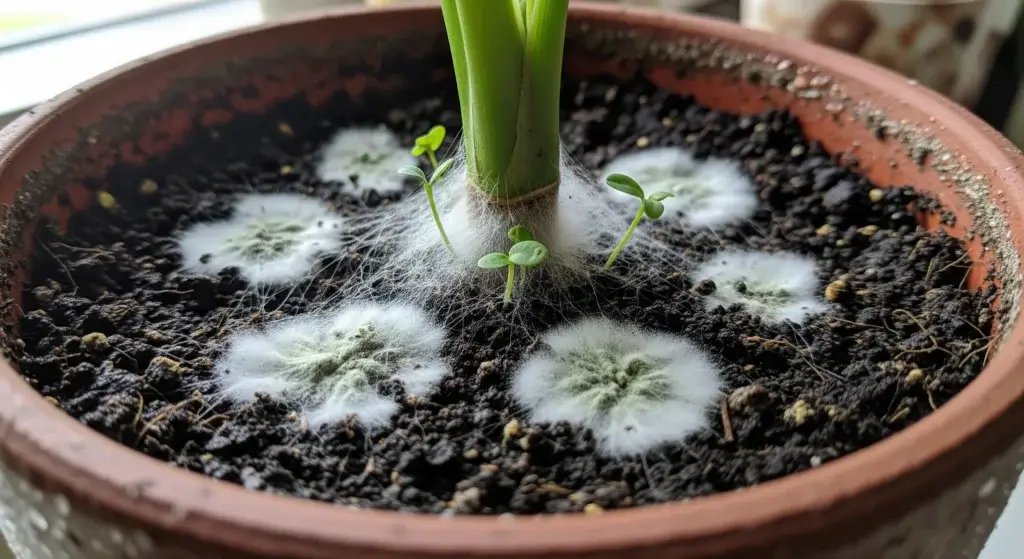
Growing mushrooms is rewarding—but pests can ruin your crop fast.
The same warm, damp space mushrooms love also attracts bugs and mites.
The good news? You don’t need chemicals to deal with it.
Natural methods work just as well (often better) and won’t mess with your setup.
This guide breaks down the 7 most common mushroom pests and shows you how to stop them—naturally.
Whether it’s fungus gnats in your oyster grow or mites in your shiitake logs, you’ll get real fixes that keep your mushrooms healthy and chemical-free.
Understanding Mushroom Pest Ecology
Before you jump into fixing pest problems, it helps to know why they show up in the first place.
Mushrooms grow in conditions most bugs love—warm temps (55–75°F), high humidity (80–95%), and organic material full of nutrients.
Basically, you’re creating a dream habitat for pests.
And unlike other crops, mushrooms don’t have built-in defenses.
No bitter taste, no protective coating, nothing to keep pests away.
That’s why prevention matters so much. Once bugs move in, they’re harder to get rid of.

7 Common Mushroom Pests & Tips to Stop Them Organicly
1. Fungus gnats
These are the pests you’ll probably deal with first—and most often.
The adults look like tiny black flies. Harmless on their own, but their larvae are the real problem.
They eat your mycelium and can wreck a whole flush if you let them.
What to look for:
- Tiny black flies hovering near your substrate
- Larvae: clear, worm-like with black heads—usually in the top layer of your substrate
How to handle it (without chemicals):
- Steinernema feltiae: These nematodes eat gnat larvae. Mix with water and spray into your substrate. They work well but need moist conditions to stay alive.
- Yellow sticky traps: Catch the flying adults. Place them close to the substrate.
- Diatomaceous earth (food-grade): Sprinkle a light layer on the surface. It shreds soft-bodied larvae. Reapply after misting.
- Let surfaces dry out: Don’t keep the top of your substrate wet all the time. Gnats love soggy conditions. Boost air circulation to help.
2. Springtails (Collembola)
They’re not always bad. But if there are too many, they’ll start nibbling on mycelium and pins.
What to look for:
- Tiny bugs (1–3mm), often white or gray, hopping when disturbed
- Usually hang out in super damp areas
How to handle it:
- Drop humidity by 5–10% for a few days: Still fine for mushrooms, but springtails won’t love it
- Used coffee grounds: Spread around the base of containers. The texture and acidity keep them away.
- Predatory mites (like Hypoaspis miles): These guys eat springtails. You can buy them online. They’re slow and steady but work well long-term.
3. Spider mites (Tetranychidae family)
They’re tiny—like, barely-visible tiny—but they can trash a mushroom crop fast, especially if your space runs warm and dry.
What to look for:
- Specks moving on caps or substrate
- Fine webbing (think cobwebs, but tighter)
- Speckled or discolored mushroom surfaces
How to handle it:
- Predatory mites: Phytoseiulus persimilis or Amblyseius californicus eat spider mites. Once released, they’ll hunt and control the population over time.
- Neem oil (only when not fruiting): Mix 2 tbsp neem oil with a gallon of water and a few drops of mild soap. Spray during downtime—never on active flushes.
- Raise humidity: Spider mites hate moisture. Keep humidity in the 85–95% range to make conditions tough for them.

4. Thrips (Thysanoptera)
Thrips aren’t picky. They’ll show up, fly around, and start chewing on mushrooms if they get the chance.
They’re small but fast and hard to spot at first.
What to look for:
- Silver or bronze streaks on caps
- Tiny yellow, brown, or black insects (1–2 mm)
- Sudden crop stress without obvious cause
How to handle it:
- Blue sticky traps: Thrips go for blue, not yellow. Put traps around grow trays and near vents.
- Predators: Orius bugs (minute pirate bugs) or predatory thrips eat pest thrips. They work well if you keep conditions stable.
- Reflective mulch: Wrap foil or reflective plastic around containers. It throws off their sense of direction and slows infestation.
5. Mushroom flies (Phoridae family)
These aren’t just annoying—they’re built for mushroom grows.
Small, hunched, and quick to run instead of fly, they lay eggs in your substrate, and the larvae wreck your mushrooms from the inside out.
What to look for:
- Flies scuttling across the surface instead of flying
- Brown, slimy tunnels in stems or caps
- Soft spots that collapse fast
How to handle it:
- Bacillus thuringiensis (Bt): Safe and targeted. Mix it with water and apply to substrate. It only harms fly larvae.
- Parasitic wasps: Spalangia and Muscidifurax hunt fly pupae. You’ll never see them work, but they’re effective once established.
- Sanitation: Don’t leave rotting mushrooms or substrate scraps around. Clean as you go. These flies love mess.
6. Mites (various species)
Different mites, same headache. Some feed on mushrooms, others spread disease.
All are hard to spot until the damage is done.
What to look for:
- Tiny moving specks on caps or substrate
- Mushrooms that brown early or rot weirdly
- Clusters of mites near decaying material
How to handle it:
- Predatory mites: Stratiolaelaps scimitus and Gaeolaelaps aculeifer are your best bet. Add them to your substrate and let them do the work.
- Essential oil sprays: Mix rosemary, peppermint, or clove oil (1–2%) in water. Spray only when you’re not fruiting.
- Heat treatment: A few hours at 85–90°F can stress mites without harming your mycelium. Use this in tight windows between flushes.
7. Slugs and snails (Gastropods)
If you’re growing outdoors or in a humid greenhouse, slugs and snails will find you.
They chew huge holes and leave slime trails behind.
What to look for:
- Ragged holes in caps and stems
- Slime trails on the floor or substrate
- Mushrooms vanishing overnight
How to handle it:
- Copper tape: Wrap it around trays or shelves. They won’t cross it. It shocks them slightly.
- Beer traps: Classic but still works. Set shallow dishes of beer away from your crops to lure them out.
- Diatomaceous earth: Create dry barriers around grow beds. Slugs and snails won’t risk crawling over it.
- Hand-picking: If your grow is small, grab a flashlight and collect them at night. Toss them far away or into soapy water.

Integrated Pest Management for Mushroom Cultivation
The best way to handle pests? Don’t wait for them to show up.
Use a system that prevents problems before they start—and keeps things under control when they do.
Step 1: Set up for fewer problems
Dial in your environment
- Mushrooms love high humidity and warmth. So do pests.
- Keep air moving. Avoid standing moisture.
- Don’t let temps swing too much.
Clean as you go
- Don’t leave old substrate sitting around.
- Wipe down trays, shelves, tools—everything.
- Mushrooms rot fast. So clean even faster.
Quarantine new stuff
- Any new spawn, substrate, or gear—check it first.
- Don’t bring outside contamination into a stable grow.
Step 2: Keep an eye on everything
Look daily
- Check your caps, stems, and substrate.
- Tiny bugs, weird spots, webbing—it all matters.
- Early signs are subtle. Catch them before they spread.
Use traps
- Yellow for fungus gnats, blue for thrips.
- Place a few near trays and vents.
- Track what you catch. It tells you what’s coming.
Write stuff down
- Keep notes on pest sightings, what you tried, and what worked.
- Over time, you’ll spot patterns. That’s how you fine-tune your system.
Creating Pest-Resistant Growing Environments
If you want fewer pests, start by setting up a place that mushrooms like—but bugs don’t.
Substrate management
Use good, well-composted substrate. Heat it right to kill any bug eggs or larvae hiding inside.
Stay away from substrates still full of raw organic stuff—that’s pest bait.
Air circulation
Stale air is a pest magnet. Set up fans or vents to keep gentle airflow going.
It helps mushrooms breathe and keeps pests from settling.
Water quality
Use clean, filtered water for misting and watering.
Dirty water can bring in pests or encourage their growth.

Conclusion
Pest control in mushroom growing doesn’t need chemicals or big costs.
Learn your pests, catch problems early, and use natural methods like beneficial bugs.
Keep your grow area clean and conditions good for mushrooms but tough on pests.
Pest management is ongoing—check regularly and stay consistent.
Whether you grow for fun or profit, these simple steps help you get healthier mushrooms and fewer headaches.



